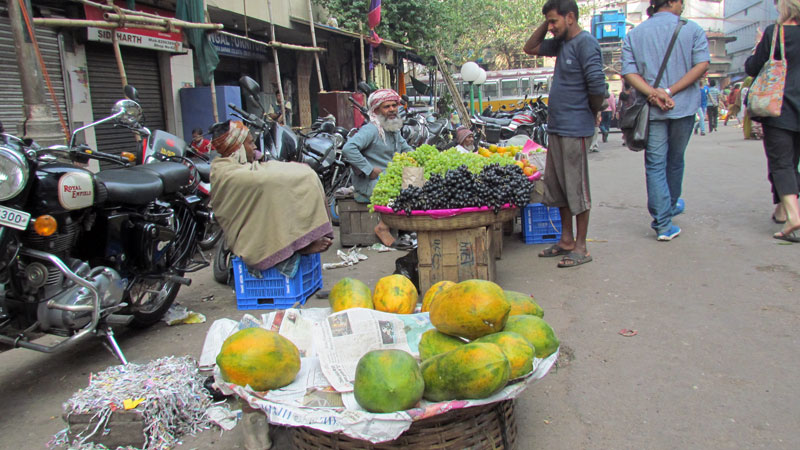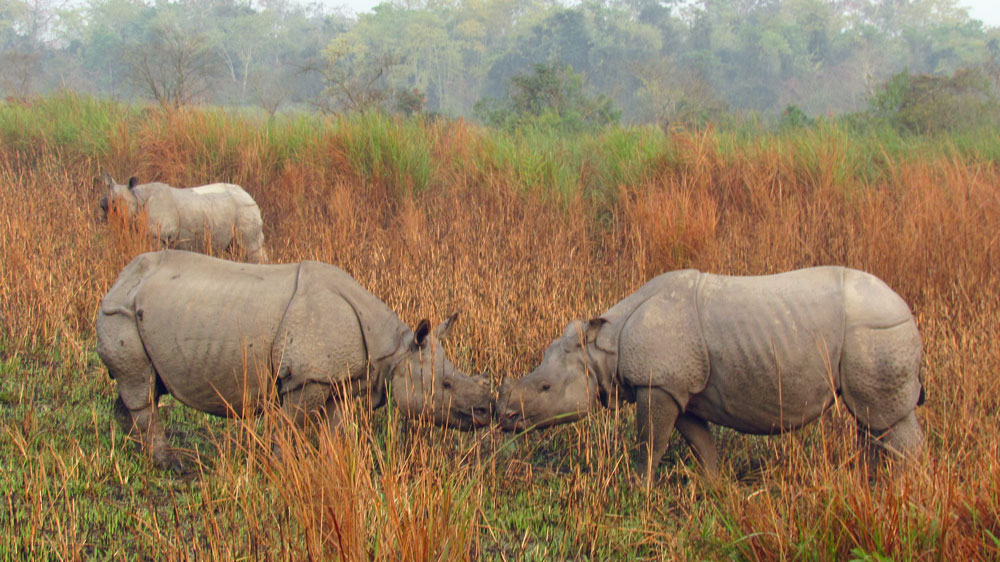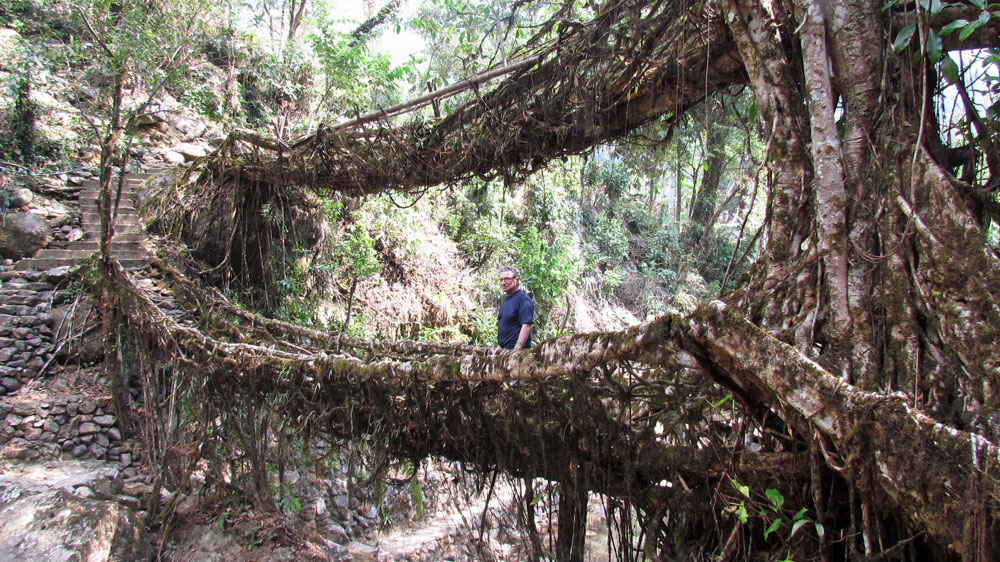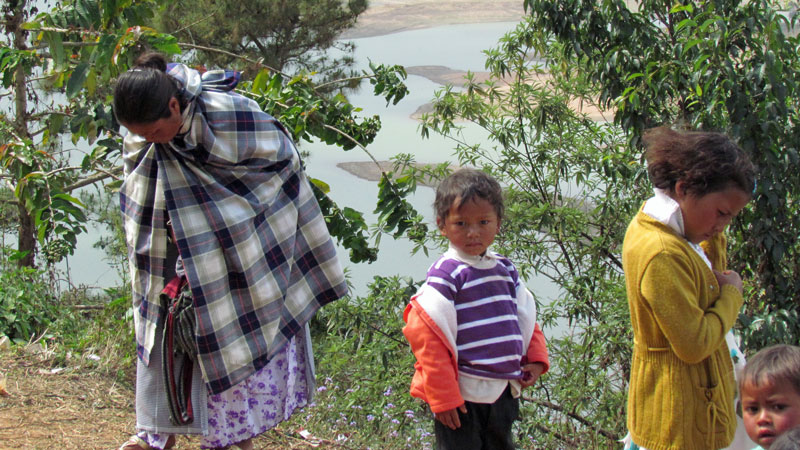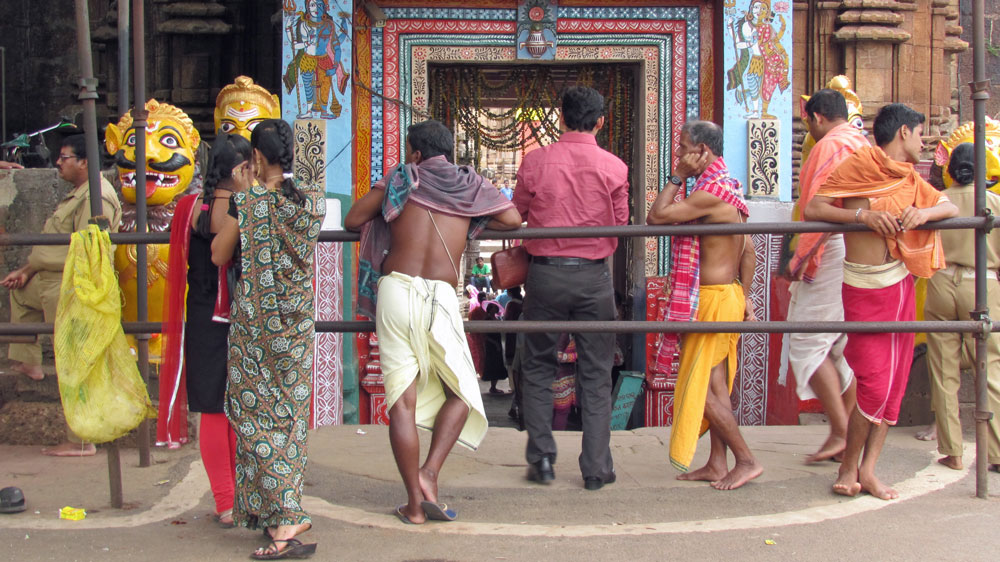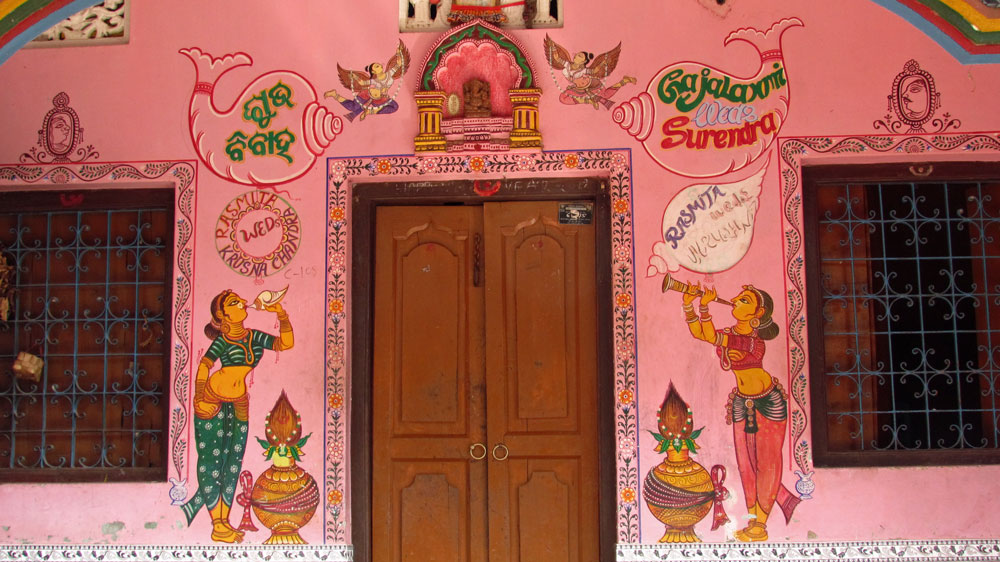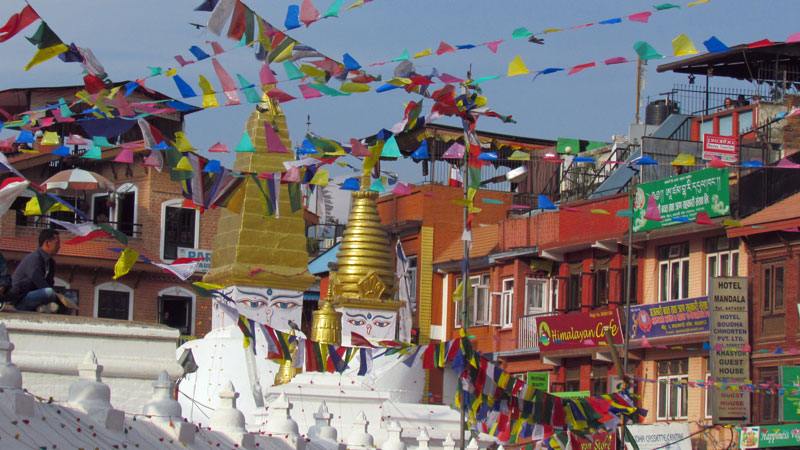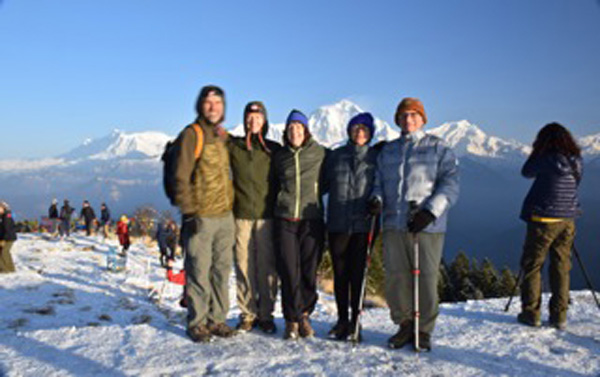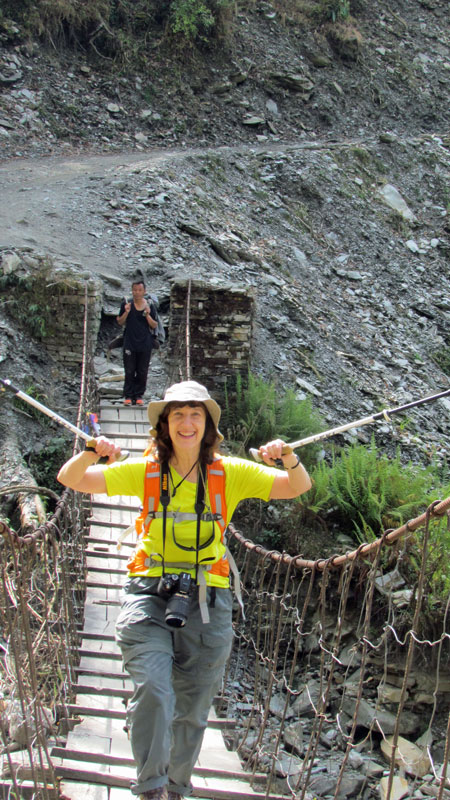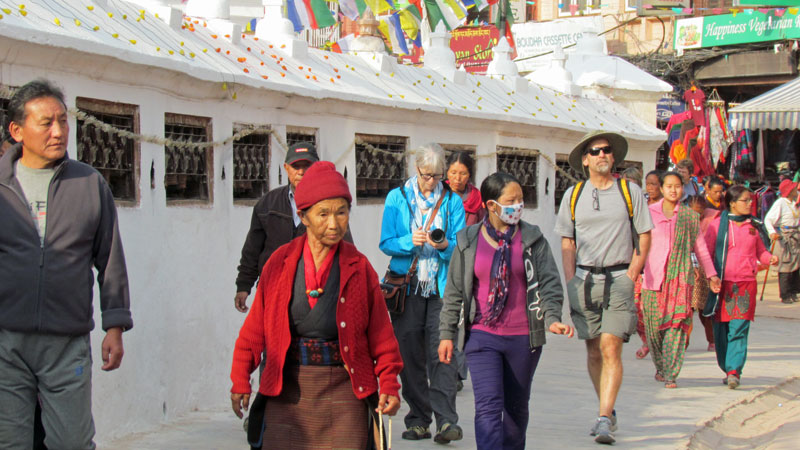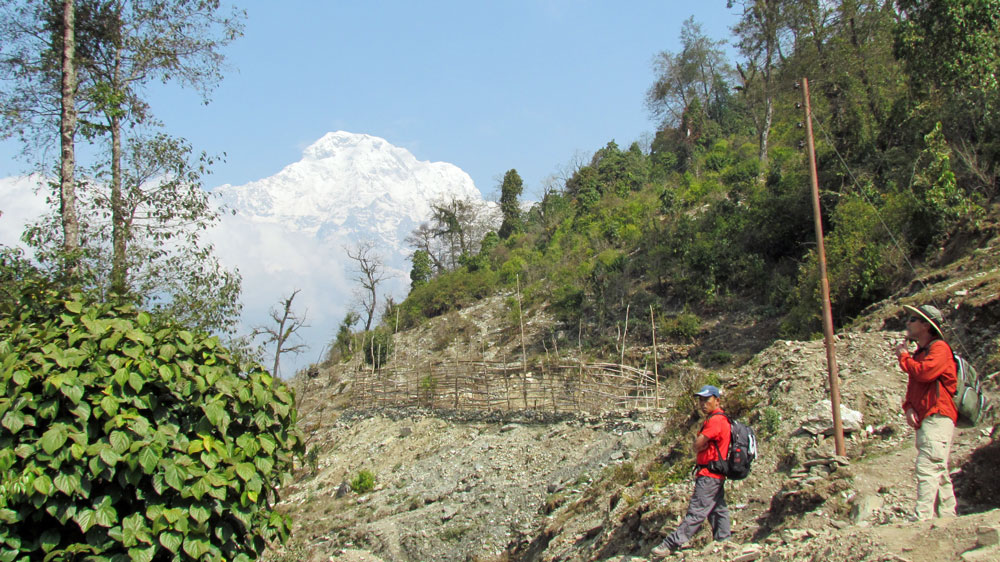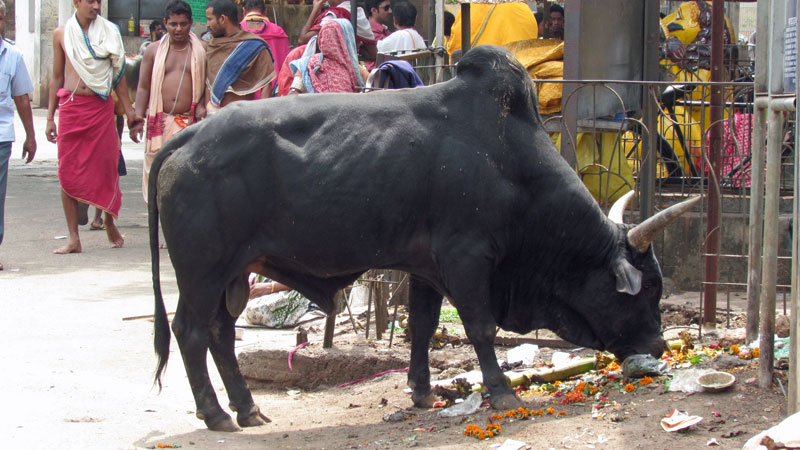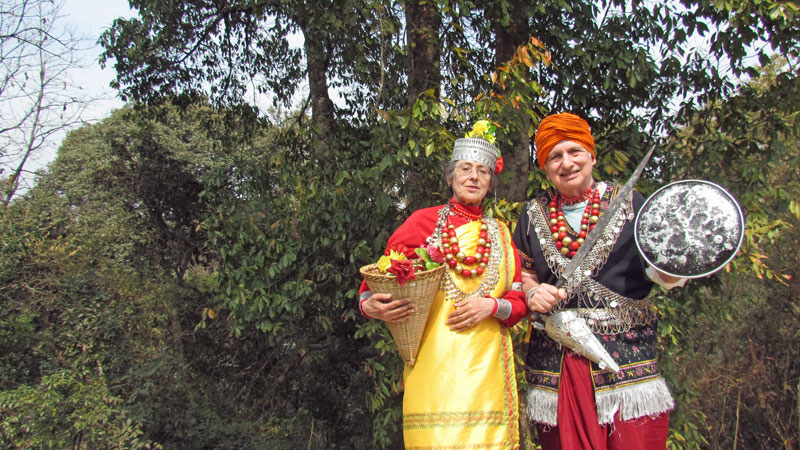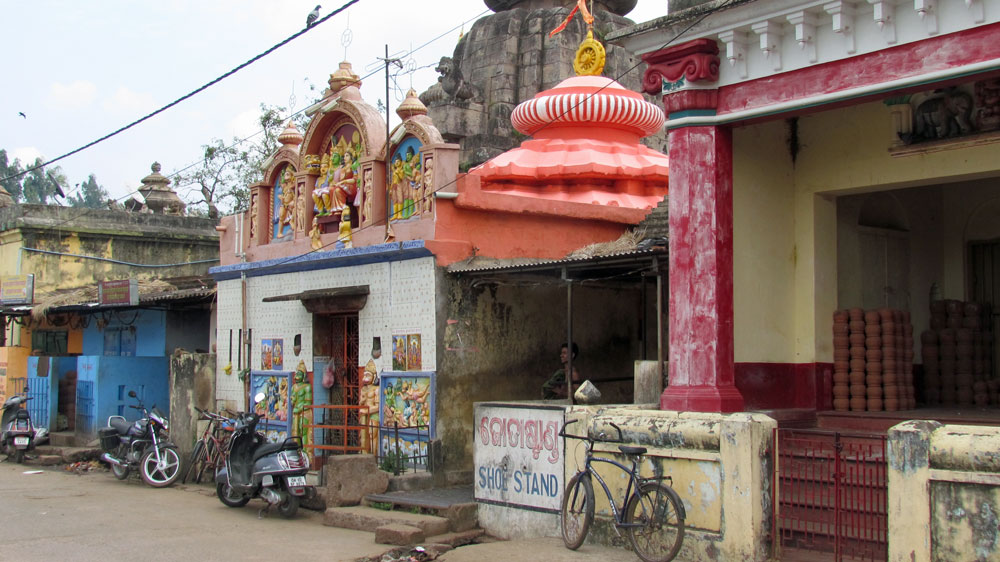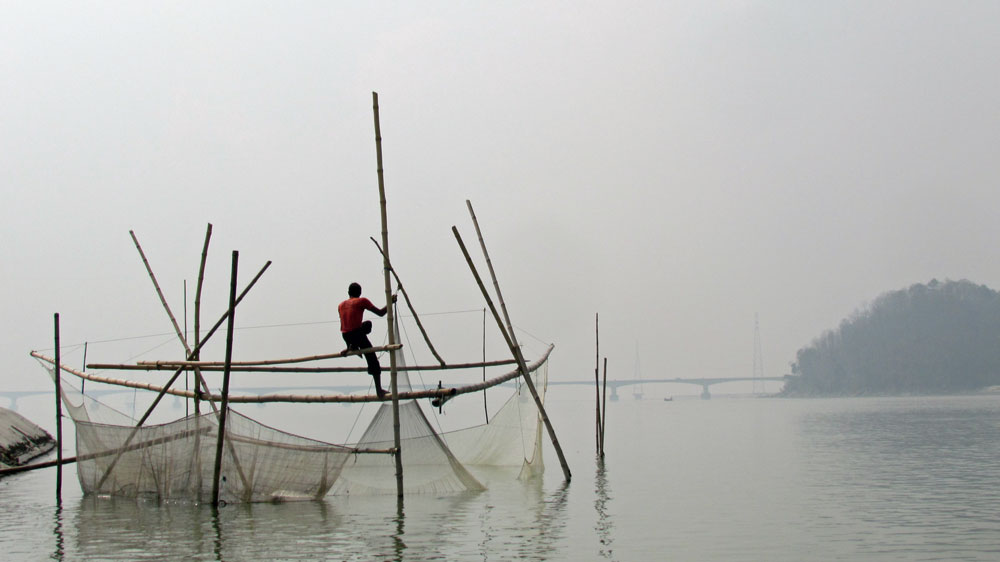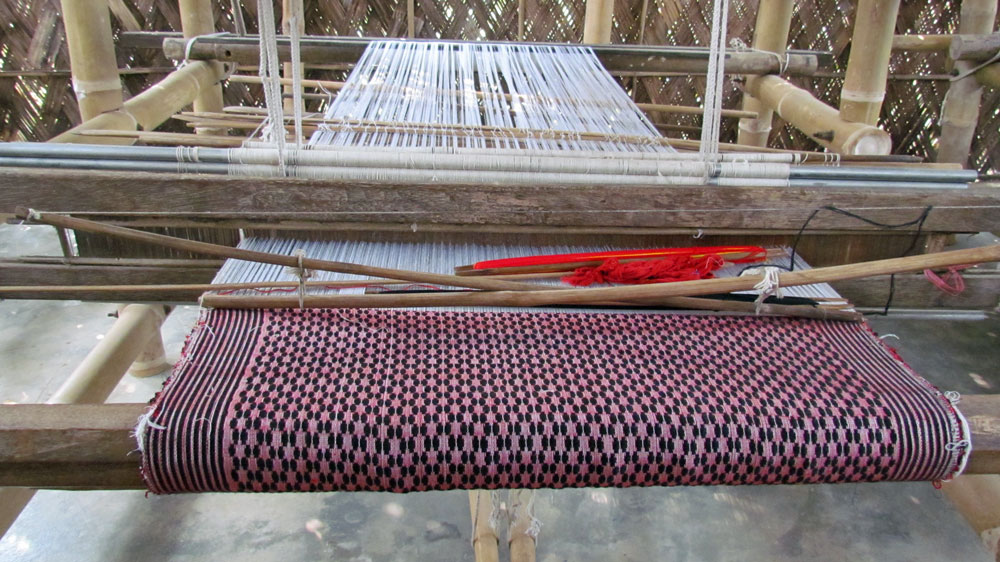We had been several times to India; but there are many Indias, and we had visited only a few. This trip was arranged by Shilpa Sharma at Breakaway. She is expert in finding unpretentious venues, and also weavers. So we flew to Calcutta (now Kolkata, but I cannot adjust) via Mumbai for a look at the country’s northeast. This region, north of Bangladesh and south of Bhutan and Tibet, is connected to the rest of India by the “chicken neck”--a map will show you. Parts of the area have been unsettled for years and require a special permit for entrance. The region is a mixture of Moslems, Christians, Hindus and others, and hence very volatile. The influx of immigrants from Bangladesh has aggravated the problems.
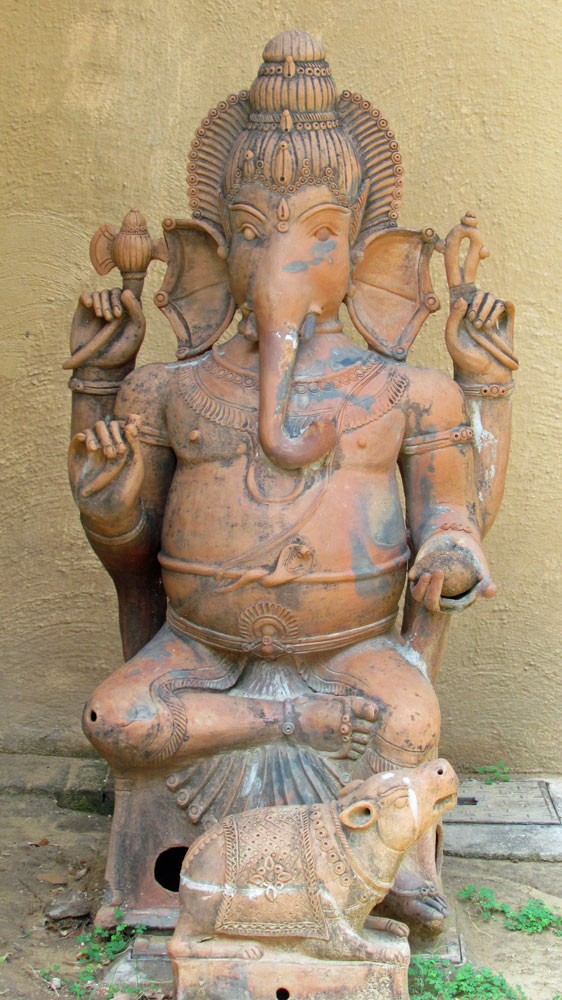
We flew to Guwahati, the largest city in the area and from what we saw an unappealing one. But we were not there long. From the airport, we were driven some six hours east to a tea plantation in Assam. Do not even think about doing your own driving in India. The roads are unpredictable in many ways, and the rules unwritten and hard to fathom. All our drivers were excellent, and we did not feel fearful (except occasionally). The road from Guwahati, like many others, was under construction. When complete, it will have two lanes each way. At the moment, only one set of lanes is (mostly) finished, and it is rarely the same set for long.
Along the way we stopped by a restaurant to have our box lunches. Suddenly the owner turned on me in a fury. His was a strictly vegetarian establishment, and I was eating chicken! I could not understand whatever language he was shouting and moved off very quickly, even though I had only been on the porch.
After six hours we arrived at the Golden Tips Bungalow, at the Wild Mahseer tea plantation. We had access to the Nameri National Park. The next morning we took a guided walk by the river, where we saw four hornbills and two tame elephants (and some wild ones). The following day we had a raft trip on the Bhramaputra to look at the dolphins. Like all Indian rivers, it was at low water. Come the monsoon, all would change with flooding eating away farm land. It is one of the country’s two great rivers, the Ganges being the other.
Our guide at the tea plantation said he would take us to meet a local weaver, in Tezpur. This was considered nearby but, given roads, traffic, cows it was still more than an hour away. Turned out we were visiting his sister-in-law and niece! The niece has a business weaving, designing and running a small workshop in the family garage. (She was the only weaver we met who was not running a non-profit.) She has five or six weavers, all women, working for her. None of them were there when we visited. She uses the various kinds of Assamese silk (Assam is famous for its silk) but does not do her own spinning. There is a large military base in Tezpur so she has plenty of business. She does not need to worry about local tastes as her customers are from all over India. Susan bought a white scarf woven in Eri or Endi silk, which is the product of domesticated silk worms and produced, Susan believes, only in Assam. It is thicker and rougher than other silks.
Wild Mahseer was a very comfortable place, with two sophisticated managers (male and female, but not a couple) and good food. But there was not a whole lot to do. It might have fit better as a relaxing conclusion to our trip, rather than the start.
Our next goal was Kaziranga National Park, a World Heritage site. It was only two hours away, but there was a problem. The upcoming elections contributed to the usual uncertainty of India. Voting was soon to start--it would take nearly two months. The Congress party leader Rahul Gandhi was visiting the area; so the opposition declared a bandh. Thus no motor traffic in the area. None. But there were time limits: we could safely leave at 5:00 in the morning or evening. We chose the latter and arrived in the dark. (India has only one time zone, so sunrise and sunset are early in these eastern states.) In the Park we luckily had the services of Trishna Nath, the only woman among the Park’s 20 or so guides. She seemed to know every bird and animal in the Park. We took two jeep tours with her and driver. She would rap on the fender to signal a stop for every creature of interest, such as an eagle or elephant. The biggest and most elusive prey was the famed Bengal tiger, the only serious predator in the Park. Trishna caught a brilliant photo of one leaping across the road. We were lucky to see a different one ourselves; they move very fast and don’t pose for photos.
The Park is famed for the otherwise rare one-horned rhino. You are promised a sighting. In fact, you will have many; their population is around 2000, and they roam placidly within easy view. The best way to see them is atop an elephant, as we discovered early the next morning. The elephants follows instructions and can approach within twenty feet of the rhinos, which pay them no attention. Poaching remains a problem in the area, and the Park rangers take it with deadly seriousness. While we were there, they shot dead two poachers who had just killed a rhino. We drove with a ranger on his way to collecting the bodies.
Susan was delighted to find a demonstration of weaving at our hotel. We met a lovely young woman, Rupjyoti Saikia Gagoi, who lives in Kaziranga with her husband, a ranger at the park and a wonderful painter and wood carver and their two sons. She was a school teacher with some knowledge of weaving who started an NGO several years ago. She and her mother teach weaving to local women, including some “tribals” who have not been to school and generally have not been involved in the local economy. Susan met some of the weavers who were working that day. They are working on a number of different projects including table runners using the tape from discarded audio tapes. Don’t feel good but look good. Also weaving saris and dupattas with women including symbols that have meaning to their local communities. They sell to local women and the tourist trade.
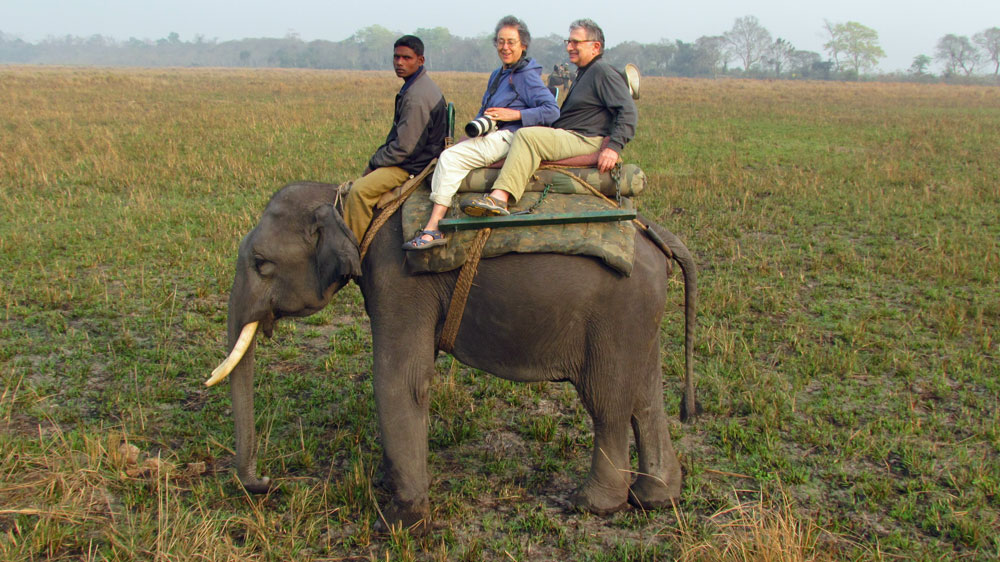
We could have spent many more days in the Park, but our schedule took us back to Guwahati. En route we encountered many men heading for a Moslem ceremony. They were going the opposite way, but nevertheless tied up traffic for nearly an hour. In Guwahati we stayed in a hilltop home above the chaos of the city. Our host was a retired mining engineer who now made paper out of rhino and elephant dung. He showed us samples, which showed no sign of their provenance.
Now we drove south to Meghalaya, another of the Northeast states. We stopped for lunch in Shillong, its biggest city. The place is not of great interest, but the many-floored Don Bosco Museum deserves a visit. Town is overrun by black-and yellow Maruti Suziki taxis. When the monsoon arrives they drive up a nearby hill to breed. After the rains they return with their young. Shillong is known as the hip-hop capital of India; it also has an annual Bob Dylan festival.
We saw women dressed in attire we’d never see anywhere else in India. (See accompanying photo.) This area is deeply Christian - Protestant (Methodist!) and Catholic. The owner of the Cherrapunji Holiday Resort lent Susan a book about the influence of the Welsh who had proselytized in this area--hymns are still sung in Welsh! On our drive through this lovely area, which has been compared to Scotland and Wales, we stopped for some fruit; the woman selling by the road was terribly disappointed that we were not Christian (we did not say we were Jewish). She was wearing a gingham checked piece of cloth, a rectangle tied at each shoulder. When it gets cold out both men and women wear brightly checked woolen shawls that look as if they could have come from Scotland. We did not see any local weaving there--we were told that people in this area had not been weavers but had traded honey and pepper for cloth woven nearby.
The people in this area are Khasia, a matrilineal society; their language was essentially oral only until the arrival of Western missionaries. Education has been highly valued and traditionally in English but, we were told, there are now some Khasi schools. We were treated to a concert of Khasia hip-hop. Susan also tried a duet of Amazing Grace with our guide singing Khasi while she sang in English. . Despite the deep influence of Christianity, many traditional religious practices are followed; clan membership is very important. A couple must be of differing clans to marry. It was interesting to see that, at the Catholic Church next to our hotel, there were several graves that had very large rectangular stones with no inscriptions (and no crosses). I was told that this was out of respect for traditional burial rites.
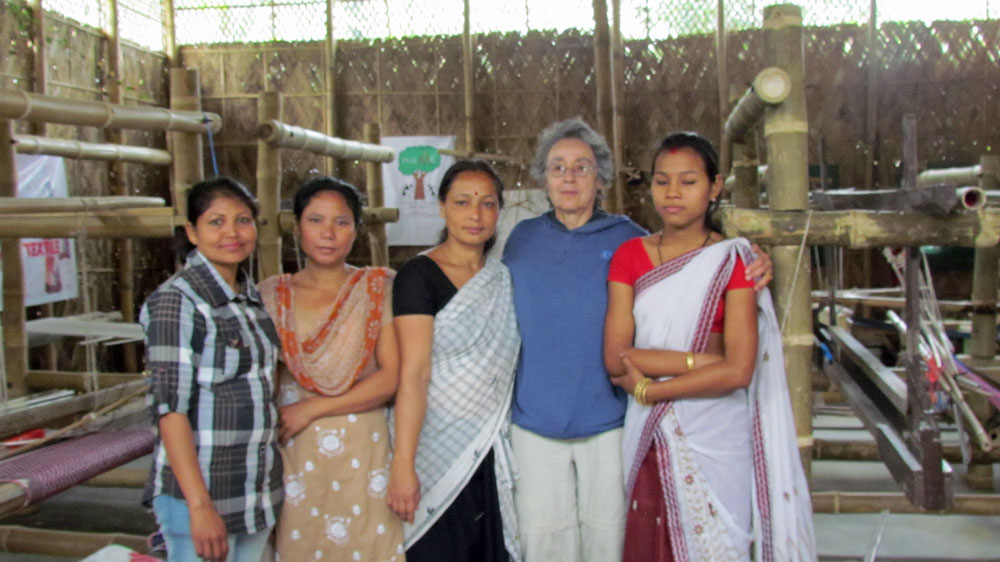
From Shillong the road climbs and curves upwards for more than an hour to Cherrapunji. Perhaps you know the name. It is the rainiest place on earth (though it has momentarily lost its title to a nearby village). The average annual rainfall is nearly 39 feet, and it comes mostly in eight months. Do the math--it’s pretty wet most of the time. Mostly dry when we were there, beginning of March. We stayed at the lovely Cherrapunji Holiday Resort (hardly any alternatives). From its hillside site you can look south over the hazy plains of Bangladesh. This is where the precipitation comes from. Clouds make up moisture from the Bay of Bengal, then drop it in torrents when the hills force the air upwards. It’s said to be very dramatic, with thunderstorms, swollen rivers and big waterfalls. People do come just for this--see Alexander Frater’s Chasing the Monsoon (1990).
Major sights include the “living bridges,” composed of the roots of rubber trees that have been stretched across the river. Seeing these organic mechanisms requires a long descent into the valley. We tried this with the equivocal aid of the Resort sketch map. We descended stone stairs for 1000 feet or so, into the forest. When the steps became indistinct, we retreated, uphill. The next day we had a 19-year-old boy to guide us. The steps were clear all the way down, but there were 1900 of them. What goes down, must rise up, I reflected grimly. We crossed the bridges, including the famous double decker. One span is about fifteen feet above the other. Living bridges, unlike the usual kind, can withstand the monsoon spate.
We did get up the 1900 steps on return. But before that I decided to bruise another limb (hadn’t done this since late summer in the Arctic). This time it was my elbow, quite a bloody gash. I was prepared, however: after soaking the injury in the very cold water (in which Susan managed to swim), I bandaged it up and headed for the 1900 steps. Upon return to the Resort, Susan observed that the elbow had resumed bleeding and that this wasn’t very nice while we were having tea. Nigel Rowe replaced my bandage and told me to keep the pressure on. “That’s a nasty gash” Nigel said. Nigel was one of five Brits who had bicycled up from Bangladesh. They were an adventurous bunch. Nigel had climbed a 20,000+ foot Karakoram peak, and the whole lot had descended the Mackenzie River in canoes. This is quite an undertaking--more than a month away from anyone else. I asked how the trip was:
“Magnificent.”
“And the insects?”
“Horrible.”
We had no time to wait for the monsoon in Cherra. We had another hillside night in Guwahati, then by plane via Calcutta southwest to Odisha (Orissa). Its capital, Bhubaneshwar, is a long-ago planned city, with boulevards and palm trees. Also hundreds of temples, many dating to the seventh century. We stayed at the Mayfair Lagoon, our most luxurious accommodation so far. There we had dinner with a fascinating young couple, Gunjan Jain and her husband. This was a textile connection--she is a weaver, whose work Susan much admired. She bought a beautiful silk ikat sari. Gunjan’s husband , Suriya Shankar Dash, is a political activist and foe of coal mining, which has long been big business in Orissa. Such opposition can be dangerous, and he had to lower his profile for a couple of years. He was thrilled that I had known the Nigerian activist Ken Saro-Wiwa, and I felt likewise about his friendship with Arundhati Roy. The marriage was virtually an international one; Gunjan was from New Delhi: different customs, different languages (Jain and Hindi).
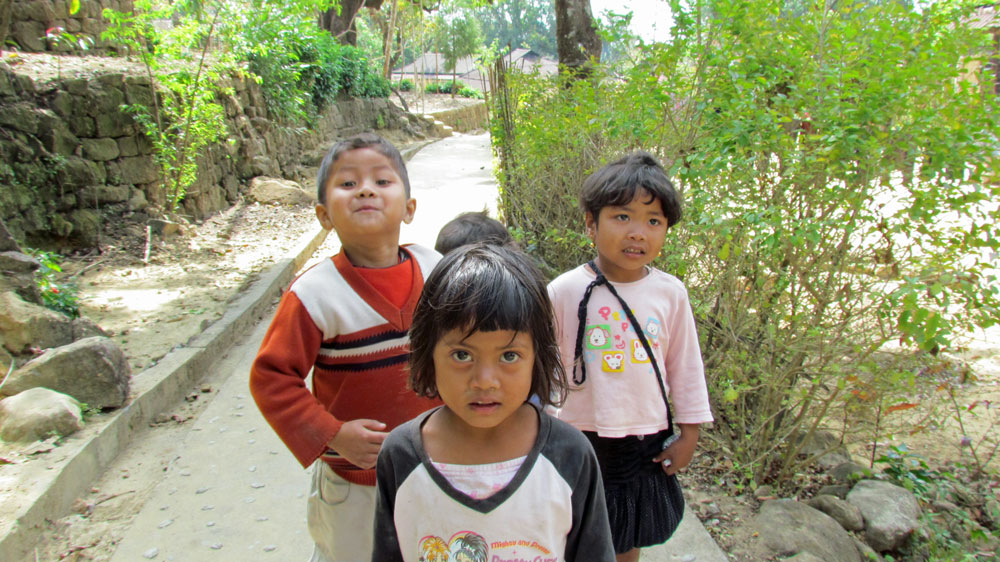
The seaside city of Puri is only an hour’s drive away. It’s a major Hindu shrine and also a resort with a tacky feel. One night in a vain search for a recommended restaurant, walked a half mile down the crowded, noisy strand. Everyone was having a good time, including a large wedding party. Little or no alcohol consumption. Not having found the restaurant, we settled on a bleak substitute where we had our one poor meal in the entire trip. Next night we found the right place, Hans Coco Palms. It was very good. The restaurant was nearly empty. At the other side three Russians, two men and a woman, were talking at high volume. Suddenly the woman slapped one of the men--hard--in the face. Then she stormed out. That’s all we know.
Next we flew back to
CALCUTTA,
where we had started more than two weeks before. It had been a rocky beginning. After the long overnight flights (actually two), we tried to stay awake and settle into our homestay in Ballygunge. It was agreeable to be in a real neighborhood, outside the busy city center. The only drawback were the dogs howling at night. As we unpacked I observed the absence of my Uplift pills. Was I looking at five weeks of despondency? A Bengali doctor said that Uplift required a prescription, which he would be pleased to write if I could produce one from a U.S. physician. With the 10-hour time difference and the idiosyncratic cell phones, this was a problem. Nevertheless the prescription did arrive on an e-mail within a couple of days. Now I simply needed the Bengali equivalent. I showed the e-mail to our tour guide, who laughed heartily. “You don’t need a prescription for that,” he said. And took me to a local pharma, where I bought a month’s supply for $4.00. A further source of mirth was that my Manhattan doctor has a Bengali name (Dutta).
Susan had not been to Calcutta, I not for almost 25 years. Everyone said that the city had changed, but my impression was that this was less true than in Mumbai or New Delhi. It remains a good place for foot travel, and we took three walking tours with Calcutta Walks . These brought us down tiny old alleys we would never have otherwise discovered. We visited an endless line of small book stalls intended for university students, as well as the famed India Coffee House. We had lunch at Peter Cat, where we ordered our guide’s recommendation, chelo kebab. It cost $12.00 for the two of us, relatively pricey by local standards. Dinners we twice took in the homestay neighbor hood, Ping@Bohemian, “where food does cabaret on the senses.”
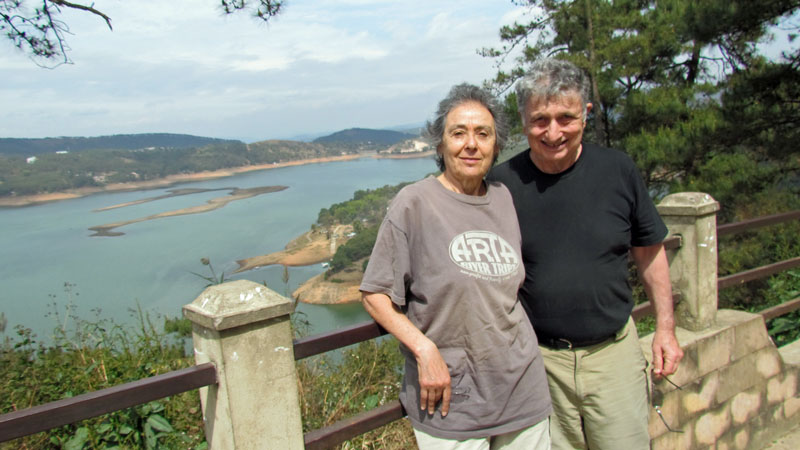
That afternoon we visited a few stores where Susan exercised extraordinary restraint, not buying anything as she knew how many other opportunities she would have. And, as usual, she has a “textile regret” about that one great dress that she didn’t buy. The next day we began some of the meetings that Shilpa had facilitated. The first was at Sasha , a fair trade, non-profit shop with items, in their Kolkata store, primarily from West Bengal. The organization has relationships with producers in several villages, including weavers in Phulia. You can see a video on You-tube of weavers in Phulia. Susan fell in love with the KANTHA cloth stitching (on natural dyed, handloomed silk); this is a skill and textile tradition originally from further East, in what is now Bangladesh. We were told that it is now practiced in West Bengal by women whose families moved after Partition. I am including photos of a scarf and a shawl that Susan bought--the stitches on the scarf, which are often white-on-white, are very difficult to see but add to the beauty of the cloth.
From Sasha we moved to Sujata Weaves and Prints, stopping off on the way for a wonderful mango lassi. Sujata was unable to meet with us so we met with her sister. She is a young dancer and, during our conversation, we learned that she had known a friend of Steve’s who, with her daughter, had a very influential dancing school. (Steve knew her, Manjusri Sircar--you can see her on http://youtube.com--and her husband when teaching in Nigeria in the ‘60’s. They later lived in New Paltz, NY for many years before returning to Kolkata.) So, even India can be a small world. Sujata is a designer who works with weavers to produce beautiful silk sarees, some of which are sold at Fabindia. It was wonderful to view and touch these beautiful silks.
On the last day we spent in Calcutta we visited a wonderful exhibition at the Rabindranath Tagore Center on Ho Chi Minh Sarani. (Although there have been many name changes of streets from English, there are still Shakespeare and Lenin Streets.) The exhibit --and conference--were called Sutra Natural Dye event; Sutra organizes conferences and prints an occasional book on dyeing and textiles. The exhibit included a display of the Thomas Wardle documents, 3,500 natural dyes (indigenous to India) that were collected in the 19th century; there were, I think, three copies made including one in Britain. But the display was from the only remaining copy and was quite fascinating. There was also an exhibit called “Colours of Nature,” a painting exhibit, and an exhibit of clothing from local designers.
We could hardly go to India without visiting Nepal, so on March 10 we flew to Kathmandu. We were met at the airport by folks from Phurba’s trekking company, Himalayan Sherpa Adventure. It was Phurba who had arranged our 1998 Kangchenjunga adventure. This time we brought him three fellow clients: my cousin Vivian from Portland (Oregon), and, from Denver, Deidre and Joe, who had been with Susan in Peru in 2012. It was the first time in Nepal for them all, and Phurba had created an easy trek for us.
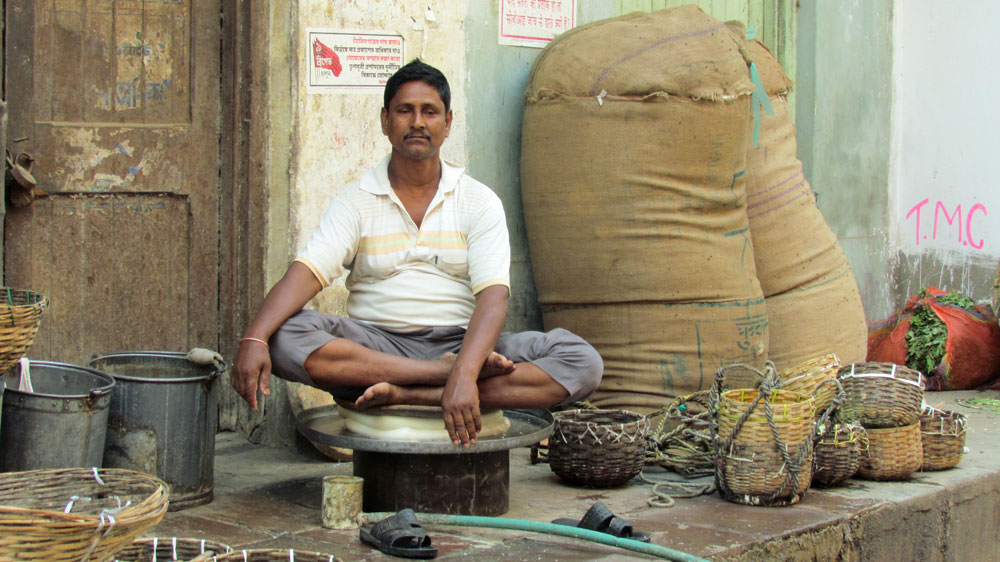
As we got out of the car at our hotel, we saw that Susan’s backpack had been left behind. She returned to the airport to search, without success. The main item lost, to her great regret, was the purchase from Gunjan. This she later replaced, and bought a new backpack.
Our arrival coincided with Losar, the Sherpa New Year. We were driven to the site of food, drink and celebration. Phurba seemed to be in charge. He has become a major figure in the local Sherpa community.
Our hotel, Shanker was near where I had been many times, but I had never seen it. It is several hundred yards behind the road (Lazimpat), and was a (grand) old palace. Its career as a hotel began 4 years ago. Not up to the Mayfair or Calcutta Oberoi, but very comfortable. Vivian (and the rest of us) did receive a nasty shock the first morning--the 42-year-old man in the room next to hers had died overnight! He had a history of heart problems; left behind two children, age three and one.
Because I had already spent so much time in the city, I skipped the usual tourist religious sites. But we did all visit again the fine museum in Patan. Highly recommended, but we foreigners now have to spend $5.00 just to enter Patan Square (the museum is an extra $2.50). We had lunch at the rooftop Café de Temple, which I remembered from seven years ago. Kathmandu has undergone many changes. There are lots of glittery new buildings, including a few high-rises. I do hope (but doubt) that they have been sturdily built, because the area is due for a big earthquake soon.
Many roads have been widened--good for traffic, but not for the buildings that lost a considerable portion of their front sections. I took a walk to Tangal, where I had lived in 1992. Didn’t find it. Maybe the neighborhood had changed beyond recognition. In a moment of nostalgia for me, we five had dinner at the Hotel Shangri-La. Its beautiful garden looks the same as when I stayed there my first time in the country, 1989.
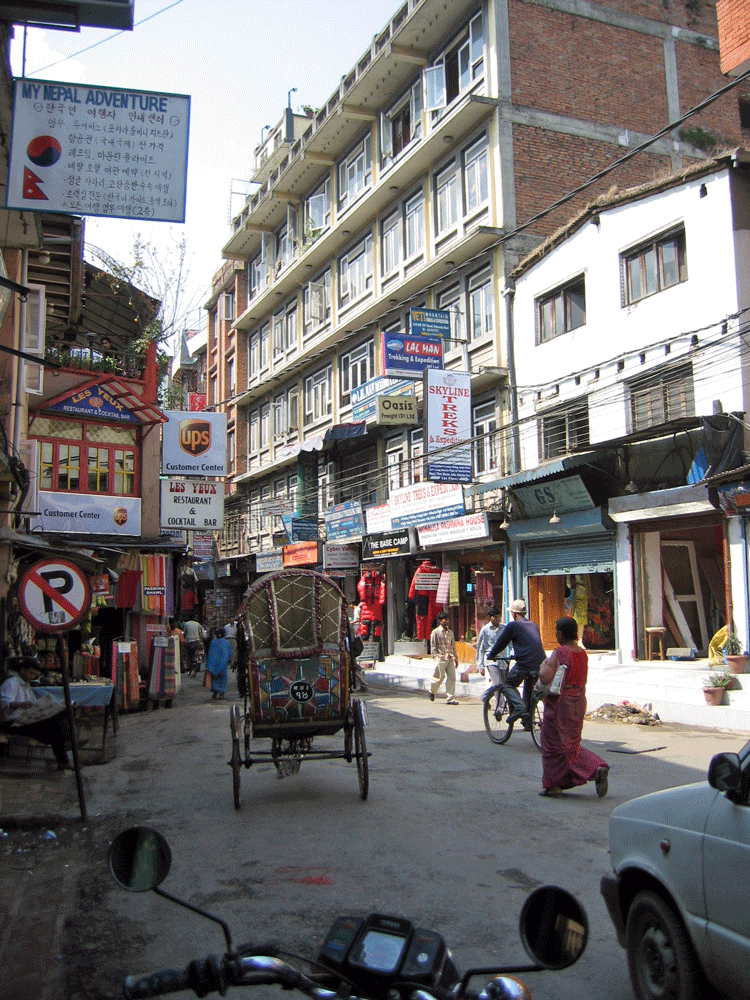
Phurba had come to the hotel to brief us on our trek. He mentioned that American clients were popular, because they gave the best tips. The Japanese gave the worst. We began March 13 with a drive west to Pokhara. Short distance, long ride--that’s what road travel is like in the country. We were not in a public bus, however, but rather a comfortable van from Phurba’s company. As we neared the town, I looked for the familiar sign for the Hotel Bedrock, but did not find it.
Pokhara consists of a commercial section indistinguishable from other such areas in the count, and the tourist lakeside. Phewa Dal is not much of a lake, but it has great views of the giant mountains only about 20 miles away. Lakeside has some new attractions, like the “om mane padme hum spa,” a neon ad for condoms and lubes, and a torso mannequin with a sign: “please feel me dear human.” Phurba had booked us into the Mount Kailash Resort, very comfortable, with swimming pool for Susan.
Comfort was reduced the next morning. After a half hour’s drive to the village of Phedi, the easy trek began. But as I perfectly well knew, Nepal has short treks and long treks, wet treks and dry treks. It does not have easy treks, especially if you are 76 years old. We started up a long, steep flight of stones. Besides the five of us, there were our leader, Pasang Sherpa and his assistant Gopal, plus two porters, each carrying about 65 pounds. We each had day packs, with water, camera, parka and such. For the next seven days, there was little level ground. Many of the trails were stone steps--many. The weather was a little cool for the season (mid-March). The (south) Annapurna Base Camp, just a few days past where we went, was reportedly deep in snow. Because the rains had not begun, we were spared the customary plague of leeches. (We regretted not introducing our friends to this experience.) The trails were clean by Nepali standards. Recycling was encouraged. In one area, plastic bottles were forbidden.
We spent each night in a trekking lodge. They were luxurious compared with the ones I recalled from Langtang in 1992: private rooms with twin beds, thin mattresses and sometimes blankets. (Our sleeping bags were part of the porters’ loads.) There were common showers and toilets that actually flushed. (Reminder: always carry your own toilet paper.) Wi-fi was usually available. We were usually on the trail by 8:00, heading up or down steeply. No later than noon we had lunch (one hour) at a tea house. Then more up and down before reaching our lodging mid-afternoon. Susan wants me to mention the hot showers that she and Vivian took at one lodge. The weather was cool and pleasant, except for occasional afternoon rain or hail, plus lightning and thunder.
Our highest stay was at Ghorepani, about 9000 feet. Then 5:00 next morning we headed up to Poon Hill. It was less than an hour away, but the stone steps were coated with hail. I promptly surrendered my day pack to Pasang and soldiered on. I reached the top for sunrise, along with 100 others, several children and a dog. The point of this effort was the view--sensational indeed. From west to east: Dhaulagiri, the Annapurnas, Gangapurna, and Machupachure. The highest points were more than 16,000 feet above us. The mountains were white, majestic and not at all inviting.
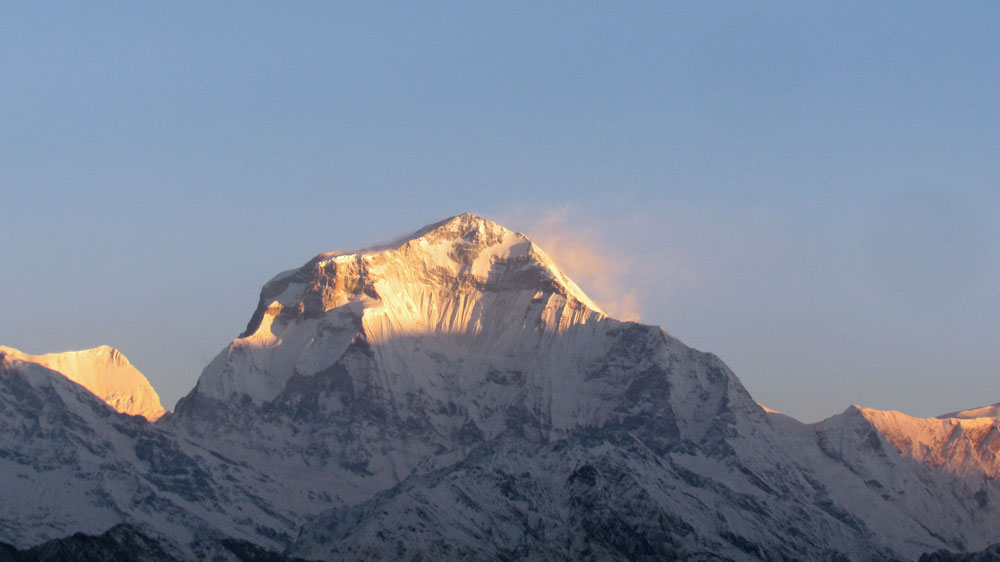
Now we were almost done. A long (ca. 4000-foot) descent took, us to our final stay, the Chandra Guest House near the river at Tirkhedunga. The following day took us a few hours to the van and the drive back to Pokhara. NOTE: Dirt roads, some of them very recent, have been built in the lower reaches of this area. There will be more, for both good and ill. Farmers will have an easier time moving their produce, but the environment will be scarred.
We flew back on Yeti Airlines to Kathmandu, where I gave a talk at a local campus. I was moderately prepared for this performance, because I can never visit the city without something of this kind being arranged by my good friend and former English Department chairman (Tribhuvan University), Shreedhar Lohani. My subject was “Mummery, Mallory, and Mystery.” A.F. Mummery was a late 19th-century British alpinist who was way ahead of his time. In 1895 he disappeared while making the first attempt on an 8000-meter peak, Nanga Parbat. Shreedhar had assembled a power point disk for me--another sign of technical aptitude in Nepal. I was able to show pictures of Everest and of Mallory. In a couple he was without clothes. These images excited amazement.
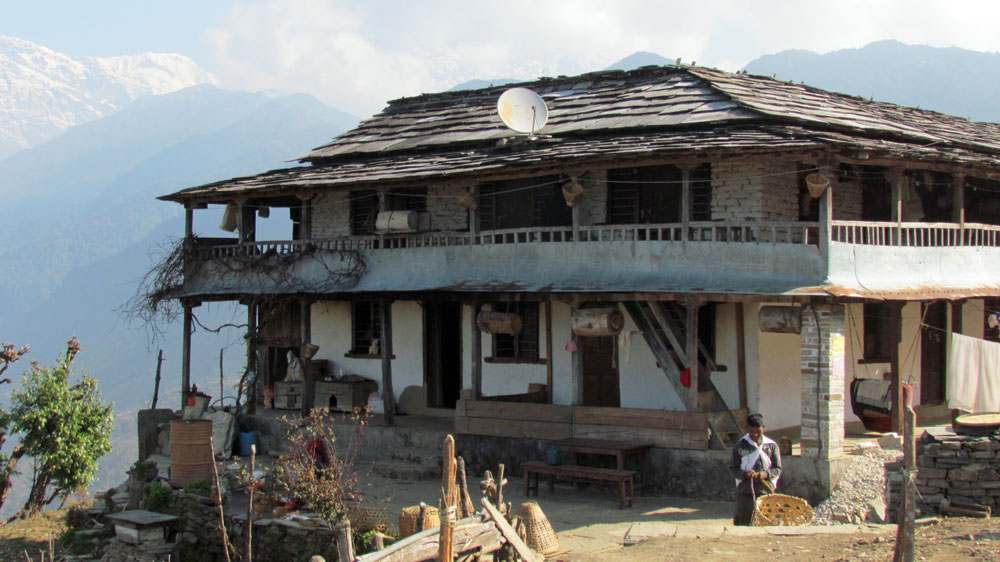
With Shreedhar in charge, you never know what is coming next. It turned out to be a restaurant dinner with all of Shreedhar’s Kathmandu family. His two sons live there, his two daughters in the Washington D.C. area. The meal was very good, but it was hard to know when it was over. We were already quite full when the main course arrived. The following night was a repetition, at an old palace, now restaurant, at which I was supposedly being honored (for what?). There was no ceremony, but the food was good.
We had now been traveling for a month, and had only one more destination:
NEW DELHI.
Shilpa had booked the five us into the Lutyens Bungalow, a leafy and quiet place, only ten minutes from the (relatively new) metro system. She had also arranged a home dinner with a local family. The husband loved to cook, very well. Shilpa, who lives in Delhi, joined us, as did the host’s young sister-in-law, a very sharp film maker of strong views.
Because we had been in Delhi a number of times, we skipped some of the standard sights, such as the Red Fort and Connaught Place. We did take a bicycle rickshaw ride through narrow market lanes that many visitors miss. And on our last morning the whole group except me took a 6:30 a.m. bicycle ride through the streets. It was reportedly a bit hair-raising.
On their flight to India, Deidre and Joe had met an American couple affiliated, in a technical capacity, with our Embassy. They invited us to dinner prepared by their excellent Indian cook. Their invitation ended “Yours in Christ” or something similar, which made us anxious. But we went, except for Viv, who sensibly stayed in the bungalow. Our hosts’ comfortable apartment had many books, almost all about the Bible. After a brief prayer, we embarked on dinner. I thought it was pretty good, but it was Mexican. Our hosts did not like Indian food. Nor did they like India, where they had lived for several more years. It was a strange evening.
Newark Airport was a 15-hour flight away. We arrived at 5:00 a.m., near the end of a snowy winter.
--Feb. 17 - March 27, 2014
ADDENDA:
--It may no longer be true, but in December 2013 the Indian government had made gaining visas an ordeal. Formerly New Yorkers could visit the Manhattan consulate and do the whole process in a day. Now an outsourced company was making an online botch of the job. We finally brought our passports to a third-party agency. We ended up paying $300 each. We made sure the visas were good for five years, so won’t have to do this again for some time.
--The vibrant India press was full of impartial reports of the coming election, e.g.: “Lulu Prasad, who pushed through the cheekiest succession act in India’s political annals by foisting his wife in the chief minister’s chair, has now spread out his dynasty by fielding daughter Misa Bharati as a Lok Sabha candidate.”
--And an item that the U.S. papers may have missed: “A young man from China, who swallowed a plastic whistle when he was 9 years old and as a result made shrill sounds while sleeping for the last 15 years, has finally removed the object.”
